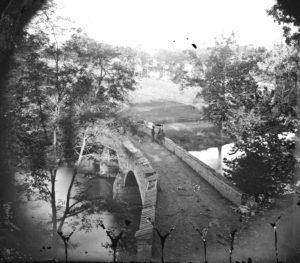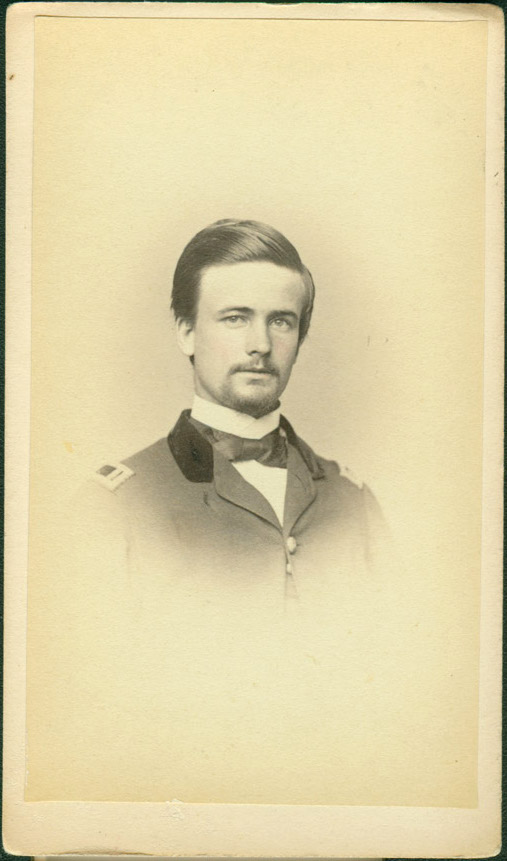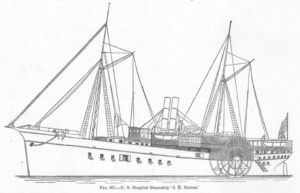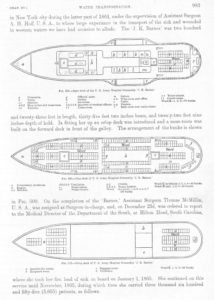Major General Jacob Dolson Cox … surrounded by images of nine of his officers (c. 1862)
15 December 2022
This set of photographs date from 1862-63 and, in addition to General Cox (center), includes 9 of his staff officers. Cox had command of the Kanawha Division/Ninth Army Corps at the start of the Maryland Campaign of 1862 and many of these men accompanied him there.
The other officers are identified, clockwise from the top:
Lt. Col. J.N. McElroy, Assistant Inspector General
Surg. W.W. Holmes, Med. Director
Capt. E.P. Fitch, Chief Quartermaster
Capt. J.W. Barringer, Chief Commissary of Subsistence
Capt. R.B. Treat, Commissary of Subsistence Inspector
Lieut. Theo. Case, Aide-de-camp
Lieut. J.W. Conine, Aide-de-camp.
Capt. S.L. Christie, Aide-de-camp.
Maj. G.M. Bascom, Assistant Adjutant General
Those whose names are links here were specifically mentioned by General Cox for their work on South Mountain that September.
__________________
This portrait photograph grouping is in the Liljenquist Family Collection of Civil War Photographs at the Library of Congress.
Wounded by one of our own shells
14 December 2022
On 22 September 1862 Brigadier General Samuel D Sturgis completed the after-action report for his Division (Second Division, Ninth Army Corps, Army of the Potomac) describing their role on South Mountain and at Antietam earlier that month.
One tiny detail from that report is the following mention of a man I’m sorry to say I’d not noticed before today:
One of my orderlies, Private John Dohmeyer, Company D, Fifth Cavalry, was severely, perhaps mortally, wounded by one of our own shells while at my side near the bridge.
That would be the Lower Bridge – now identified as Burnside’s – over the Antietam near Sharpsburg, MD.
The orderly’s wound was in fact mortal, though the General couldn’t have known that for sure as he was writing. Private Domeyer died at the Locust Spring field hospital on 23 September, the day after the report was submitted.
_______________
Being German-born, his name was probably mangled by various record keepers – at his enlistment, in the regiment, by General Sturgis, and at the hospital – so I’m not sure how it should be spelled. It is likely he was born Johann Domeyer, as that name appears in several Bavarian genealogies, so I’ve used the Americanized first name John with that surname on his record at Antietam on the Web.
I’d be glad to hear from anyone who can help me nail that down.
This incident also illustrates how near General Sturgis came to his own death on 17 September 1862; I wonder if that was the point.
The photograph here is in the collection of the Library of Congress and is titled Antietam, Maryland. Burnside bridge. [Photographed from a tree?]
Assistant Surgeon Thomas W McMillin (c. 1862)
7 December 2022
This expressive photograph of a young Assistant Surgeon Thomas McMillin was kindly shared to the FamilySearch database [free login required] by Kelly Harrison Thomas in 2021. Dr. McMillan was Medical Purveyor of the Army of the Potomac at Antietam in 1862 and into 1863.
In 1864 and 1865 he was in charge of US Army hospital steamships Baltic and J.K. Barnes (named for the US Army Surgeon General). Here’s more about the J.K. Barnes from the Medical and Surgical History of the War of the Rebellion (Vol. 2, Pt. 3).
McMillan died young of heart disease in April 1873, still in US Army service.





